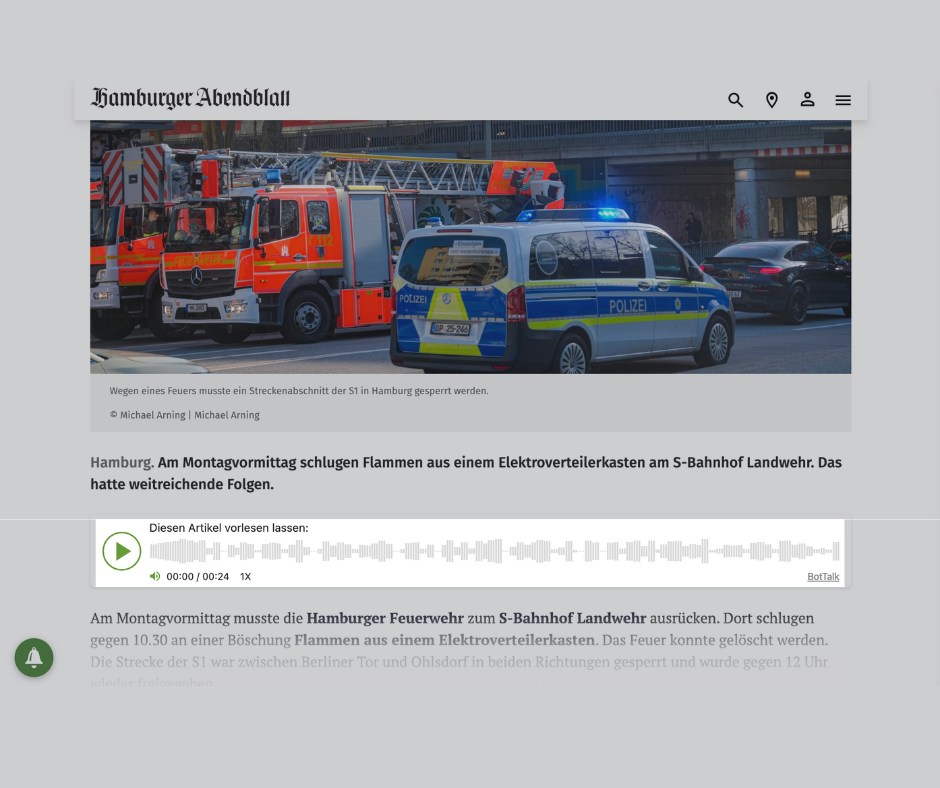Tone of voice and speaking style: What do they mean for your brand?

The tone of speech affects the meaning and impact of your brand's message more than ever. Whether it's through written words, spoken audio, or interactive voice response (IVR) systems, the way your brand communicates with customers across all touchpoints is crucial. That's where the power of natural-sounding speech and AI-driven Text-to-Speech (TTS) technology comes into play. With the ability to convert text into natural-sounding voices in multiple languages, TTS platforms offer a unique voice to your brand while enhancing accessibility and personalized customer interactions.
In this article, we will explore the key features and benefits of using AI-powered TTS systems to transform your brand's spoken content, making it more engaging, relatable, and accessible to a wider audience, ultimately improving the overall customer experience.
Table of Contents:
1. Defining the significance of tone of voice and speaking style
2. The impact of brand communication on consumer perception
3. The Power of AI-Powered Text to Speech Technology
4. Leveraging AI for precise control of speaking styles
5. Case studies of brands using AI for customized speech
6. How AI enables real-time adjustments in speaking style
7. Balancing automation with human authenticity
Defining the significance of tone of voice and speaking style
Understanding the impact of a brand's tone of voice and speaking style is crucial in today's market. The tone of speech profoundly affects the meaning conveyed to the consumer, shaping their perception of the brand personality. Natural sounding speech, especially in customer service, can significantly enhance customer interactions.
For instance, when using text-to-speech (TTS) technology, a natural sounding voice can make the difference between a pleasant user journey and a frustrating one. Brands now recognize the importance of having a custom voice that aligns with their identity, moving away from robotic voices that often detach from the human element. This shift towards human speech and natural sounding voices in areas like interactive voice response (IVR) systems and customer service agents reflects a broader understanding of how spoken words influence customer sentiment.
Speech synthesis technologies, including advanced AI voices, are increasingly adept at mimicking human voice qualities, thus making brand communication more relatable and engaging.
In the digital era, the versatility of speech software extends beyond just what we hear. Text-to-speech (TTS) tools, such as AI text to speech systems, are essential for creating audio files from written text, offering multilingual support and catering to a global audience. This technology allows brands to generate speech in multiple languages, ensuring all customer touchpoints are covered.
For educational materials like training videos, natural sounding voices read aloud the content, greatly aiding comprehension skills, especially for those with learning disabilities or visual impairments. The key features of modern speech voices include the ability to add pauses, adjust speaking rate, and control reading speed, which are pivotal in enhancing the accessibility of spoken content.
Moreover, synthetic voices, developed through AI and speech synthesis, enable brands to save money while offering high-quality, natural sounding, and easily comprehensible speech. This technology is not just about converting text into spoken words; it's about creating a unique voice that embodies the brand's identity, enhancing customer service and improving accessibility for users with different needs, such as those with other learning disabilities or hearing difficulties.
The impact of brand communication on consumer perception
The tone of speech in brand communication crucially shapes consumer perception. Leveraging text-to-speech and AI voice technologies, brands can generate natural sounding, synthesized speech across multiple languages, enhancing engagement at all customer touchpoints.
These AI-generated voices, adaptable in speaking rate and sentence structure, effectively convert text into audio, ensuring content is accessible for users with different needs, including those with reading difficulties. Such advancements in speech synthesis and playback not only enrich the user journey but also reinforce the brand's identity through consistent, personalized communication.
How tone shapes brand personality
The tone of speech is a pivotal element in defining a brand's personality, significantly influencing how its message is perceived and understood. Advancements in text-to-speech and speech synthesis technologies have empowered brands to craft a custom voice that embodies their identity, utilizing AI voices to generate speech that not only sounds natural but also resonates with the audience in multiple languages.
This approach, involving synthetic voices with the ability to read aloud online text and audio files with tailored sentence structures and speaking rates, is integral at all customer touchpoints. From AI voice-driven contact centers to audio playback in Youtube videos, brands are increasingly using synthesized speech to convert written content into engaging audio formats.
These technological solutions not only cater to a wide range of users, including those with reading difficulties, but also ensure that the brand’s voice remains consistent and distinctive. By carefully selecting the tone, language, and features of their AI-generated voices, brands can significantly enhance their personality, making each interaction more impactful and memorable for the audience.
The Power of AI-Powered Text to Speech Technology
The power of AI-powered text to speech technology lies in its remarkable ability to transform the interaction between brands and users. By utilizing artificial intelligence to convert text into synthesized speech, this technology enables a natural sounding voice to emerge from mere words.
The tone of the speech, meticulously crafted by AI, significantly affects the meaning and reception of the message, thereby enhancing user experience across various platforms. From generating speech for contact centers to providing audio files for online text, AI-powered text to speech technology ensures that every communication touchpoint is covered.
With features like a BotTalk audiohub, users can easily convert free text into audio, allowing for a more accessible and efficient way to consume content. The ability to add pauses, adjust reading speed, and choose from different languages and voices, empowers brands to create a custom voice that truly resonates with their audience. Whether it’s reading an online article or interacting with customer service, the synthesized voice and speech provide a more engaging and inclusive experience.
This technology not only speaks in a human voice but also embodies the brand's identity at all customer touchpoints, revolutionizing the way information is conveyed and heard.
Leveraging AI for precise control of speaking styles
Leveraging AI for precise control of speaking styles has revolutionized the way we understand and utilize speech in various domains.
The tone of the speech, a crucial element that profoundly affects its meaning, can now be finely tuned using advanced text-to-speech technologies. These AI-driven systems enable the creation of custom voices that can generate speech, mirroring the nuances of human voices.
This capability is particularly beneficial for converting free text into dynamic audio files, ensuring that the intended message is conveyed accurately across all customer touchpoints. Whether it's through a speech reader or directly embedded in digital content, AI allows for a seamless conversion of text into audible speech.
The flexibility to modify language, tone, and even the specific words spoken, opens up a new realm of possibilities in how voice and speech can be used to enhance user experiences. By precisely controlling these aspects, AI ensures that the message is not just heard but is also delivered in a manner that is most impactful and engaging to the audience.
Case studies of brands using AI for customized speech
There are various case studies of brands successfully utilizing AI to create customized speech, demonstrating how the technology has become integral in enhancing brand communication. By leveraging text-to-speech tools, these brands have mastered the art of generating speech that not only embodies a custom voice but also captures the nuances of human voices.
This approach ensures that the tone of the speech, a key factor affecting its meaning, is precisely tailored to align with the brand's identity at all customer touchpoints. Whether it's through converting free text into engaging audio files or using a speech reader to facilitate communication, AI has empowered these brands to speak in a language and voice that resonate with their audience.
The case studies highlight how effectively AI converts text to speech, allowing brands to hear their written words come to life in a manner that significantly enhances customer interaction. This sophisticated use of AI in crafting voice and speech demonstrates its potential in creating a more personalized and impactful brand experience.
Voice-Activated Smart Devices
Several brands like Samsung, LG, and Sony have harnessed AI for customized speech, creating a more intuitive and user-friendly experience.
These case studies showcase how the tone of speech, carefully curated through text-to-speech technology, significantly affects the device's interaction with users, making communication more natural and meaningful. By integrating AI across all customer touchpoints, these brands have developed smart devices that not only understand and speak in multiple languages but also adapt their voices to suit different contexts and user preferences.
The ability of these devices to convert text into audio files with a distinct voice and language setting enhances their appeal, providing a seamless and personalized audio experience.
This innovative use of AI in voice-activated devices exemplifies how brands are evolving to meet user needs through advanced speech technology, making everyday interactions with technology more engaging and efficient.
German publishing houses

German publishing houses like FUNKE, NOZ, MOPO, VRM, Mediahuis, Mediafin, and VRT are revolutionizing news consumption through AI-driven text-to-speech technology, showcased vividly in their use of BotTalk audiohub.
These prominent publishers are at the vanguard of a significant shift, transforming thousands of written articles into audio formats daily. This innovation not only diversifies the presentation of news but also significantly boosts reader engagement. Remarkably, 10% of their readership chooses to listen to their news, with a striking 75% listening attentively until the article's end, leading to an average engagement time of 3.5 minutes.
Moreover, these publishers are capitalizing on the advantages of text-to-speech technology by incorporating audio articles into their premium services and creating new opportunities for audio advertising. This strategic adoption of customized tone of voice and speaking style in audio content exemplifies how AI can profoundly enhance user experience and open up new business avenues for publishers and all your customer touchpoints.
How AI enables real-time adjustments in speaking style
The integration of AI in text-to-speech technology has ushered in a new era of dynamic communication, enabling real-time adjustments in speaking style to suit various contexts.
This advancement means that the tone of the speech affects the meaning, a crucial element that significantly of communication, can now be modified on-the-fly to align with the specific needs of different customer touchpoints. AI-driven systems can analyze and adapt the nuances of voice, language, and even the subtleties of different voices, ensuring that the spoken content is not only appropriate but also engaging for the listener. Whether it's generating an audio file for a customer service interaction or providing voice assistance in multiple languages, AI's capability to instantaneously adjust speaking styles revolutionizes how brands communicate, making each interaction more personalized and impactful.
This flexibility in speech delivery, powered by AI, marks a significant stride in enhancing the effectiveness and versatility of audio communications.
Balancing automation with human authenticity
The balance between automation and human authenticity is key.
AI's capability to fine-tune the tone of speech, an element crucial in affecting meaning, brings a nuanced human touch to automated systems. Through advanced text-to-speech technology, AI can generate audio files that not only speak in various languages but also emulate the warmth and inflection of human voices. This allows for a more natural and engaging interaction at all customer touchpoints, whether it's through information delivery or customer support.
The ability of AI to craft a voice that can speak with authentic tonal variations transforms the auditory experience, bridging the gap between the efficiency of automation and the personal connection of human speech. This delicate balance enhances the overall impact of audio communications, making them more relatable and effective for users.
